Key takeaways:
- Open-source wallets offer transparency and user empowerment, allowing individuals to inspect and customize the software managing their cryptocurrencies.
- Benefits include a collaborative community that enhances security, customizable features, and improved user experiences compared to traditional wallets.
- Key features to consider when choosing wallets are compatibility with various cryptocurrencies, user-friendliness, and robust security measures like two-factor authentication.
- Popular open-source wallets like Electrum, Mycelium, and Trust Wallet are recognized for their user-friendly interfaces and seamless management of multiple cryptocurrencies.
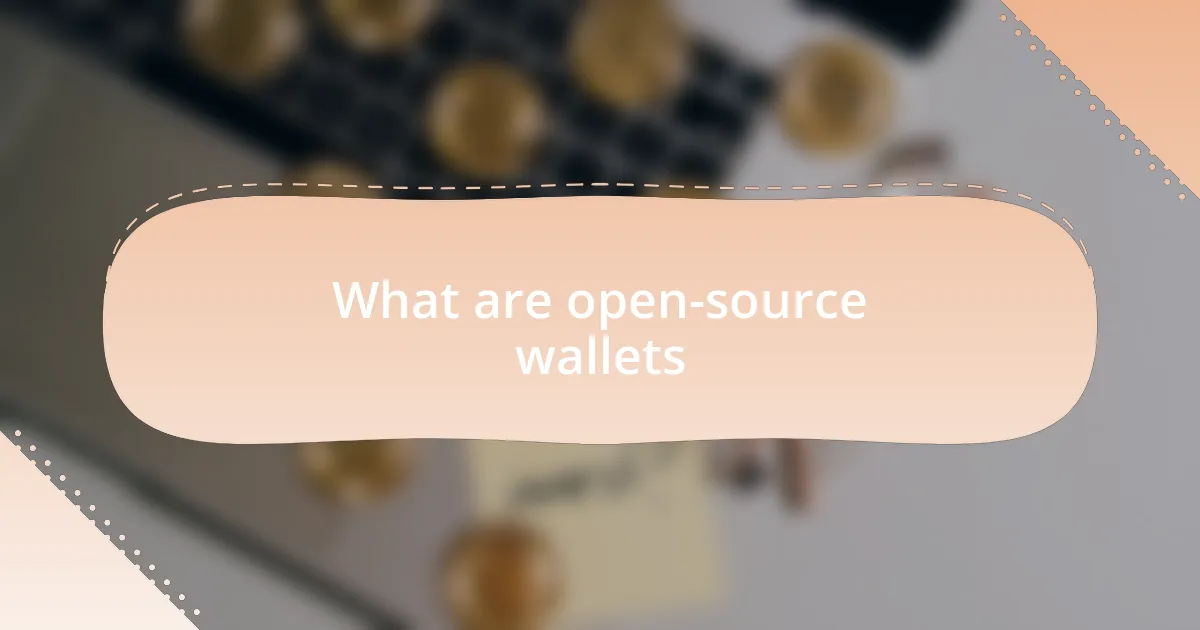
What are open-source wallets
Open-source wallets are software solutions for managing cryptocurrencies where the source code is freely available for anyone to inspect, modify, or enhance. I remember when I first stumbled upon an open-source wallet—seeing how a community could actively contribute to improving the security and functionality was incredibly intriguing. It made me appreciate the collaborative spirit of the crypto space, where users aren’t just passive participants but active contributors.
These wallets offer transparency, allowing users to verify the code and trust that their funds are managed securely. Have you ever wondered how that level of trust can change your perspective on digital assets? For me, it felt empowering to know that my wallet wasn’t a black box; I could see every line of code and understand exactly how my cryptocurrencies were being handled.
Moreover, open-source wallets often come with a variety of features tailored by user feedback. Personally, I find that the ability to request and implement new features draws me closer to the developer community. It’s like being part of a collective journey where our insights shape the paths we take in managing our digital currencies.
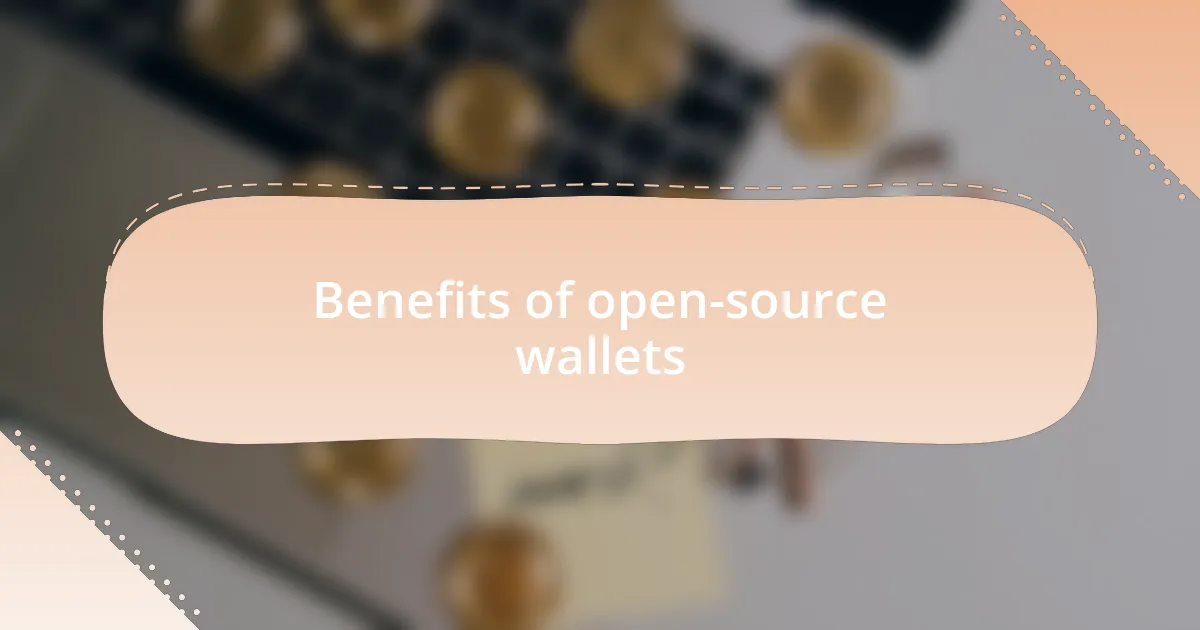
Benefits of open-source wallets
There’s a profound sense of community found in open-source wallets that can be hard to capture in traditional financial tools. I remember the joy I felt when collaborating with fellow users to troubleshoot an update on one of my favorite wallets. This kind of collaborative spirit not only fosters innovation but often leads to quicker identification and fixing of security vulnerabilities.
Another benefit that stands out to me is the freedom to choose customizable features. I once switched wallets simply because one offered a unique transaction categorization tool that helped me track my spending habits more efficiently. It’s remarkable how these tailored solutions can enhance individual user experience, transforming the often overwhelming world of cryptocurrency into something more digestible and manageable.
Additionally, the open-source nature of these wallets often translates into better security practices. When I learned that more eyes on the code meant more opportunities for catching potential issues, it truly shifted my perspective on security. Doesn’t it feel reassuring to know that users like me and you are actively working to fortify the software we trust with our assets? This gives me an added layer of confidence that proprietary wallets simply can’t match.
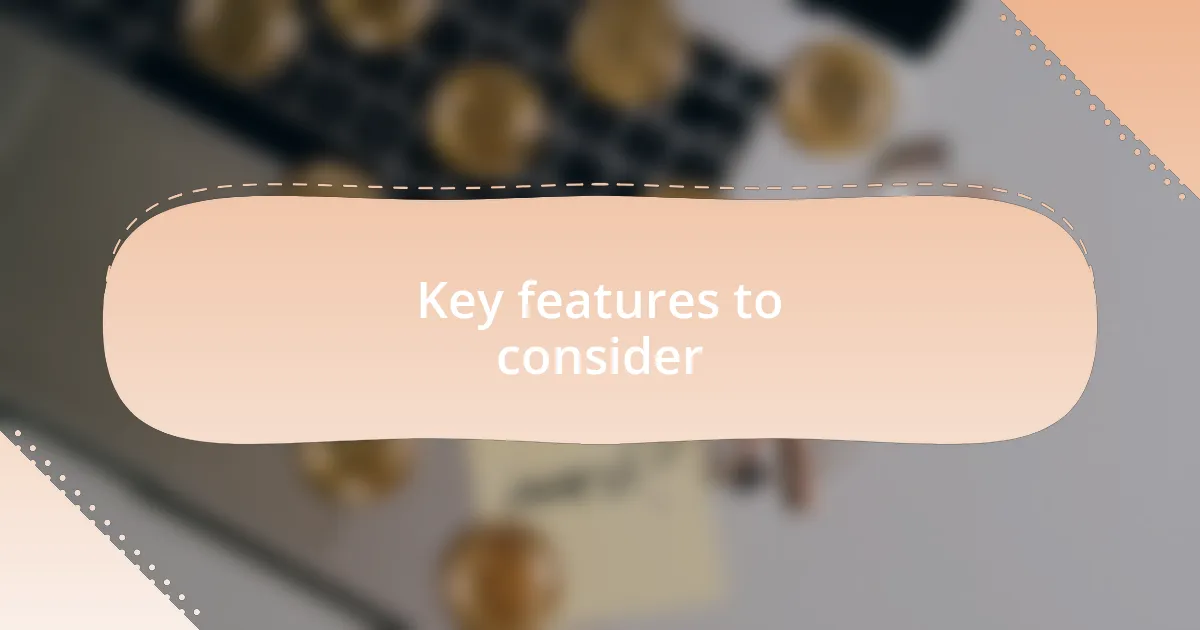
Key features to consider
When evaluating open-source wallets, one key feature to consider is compatibility with different cryptocurrencies. I’ve had experiences where my wallet didn’t support a specific token, and it was frustrating trying to find a workaround. By opting for a wallet that accommodates a wide range of cryptocurrencies, you can avoid this headache and feel more empowered in managing your diverse assets.
User-friendliness is another critical aspect to think about. I recall switching to a new wallet that looked sleek but ended up being overly complicated. It’s essential to strike a balance between functionality and ease of use; nobody wants to spend hours figuring out how to make a simple transaction. A wallet that prioritizes intuitive design can enhance your overall experience, allowing for smoother navigation and quicker access to features.
Security features should be at the forefront of your considerations. In my early days of using cryptocurrency, I made the rookie mistake of underestimating security protocols. I now understand the importance of two-factor authentication and strong encryption. These measures are not just buzzwords; they serve as vital barriers against potential threats. Why compromise your hard-earned assets when robust security options are readily available?
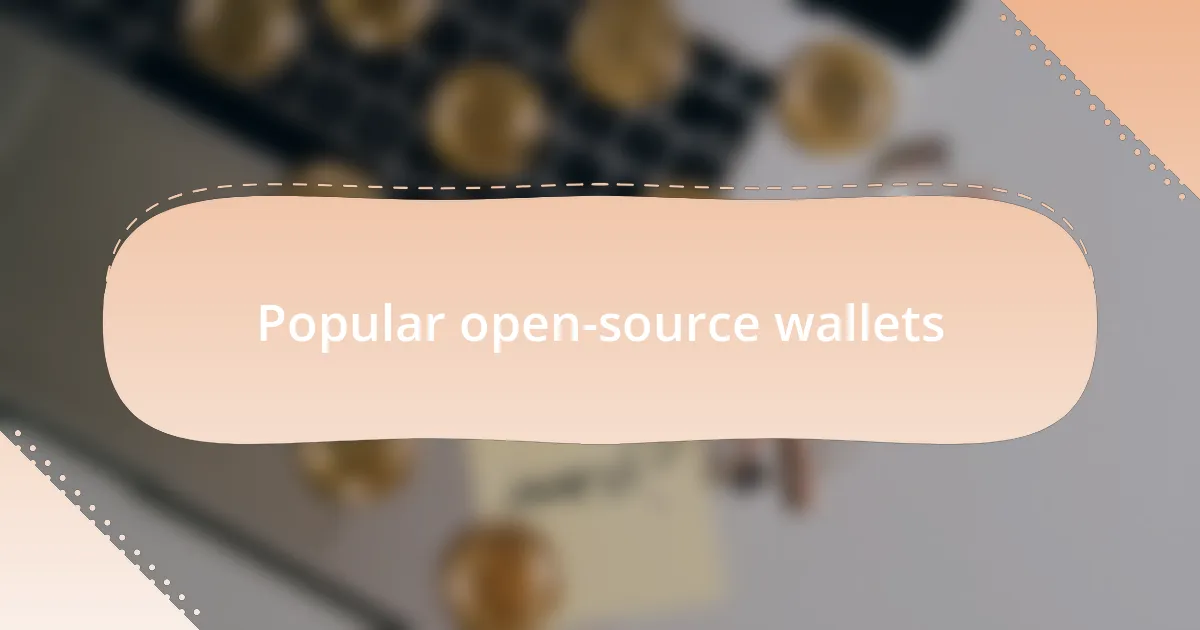
Popular open-source wallets
When it comes to popular open-source wallets, I’ll share my thoughts on a few that have caught my eye. One standout is Electrum, which I found surprisingly lightweight yet packed with features. It supports Bitcoin and can integrate with hardware wallets for added security—perfect for users like me who prioritize protecting their assets while still enjoying flexibility.
Another wallet that I appreciate is Mycelium. I remember my first transaction using Mycelium; it felt intuitive and smooth! It’s primarily geared towards mobile users, which is ideal if you’re on the go like I often am. What I love most is its ability to interact with other wallets and its built-in exchange feature, making it super convenient for those spontaneous trades.
Lastly, there’s Trust Wallet, which has been making waves in the crypto community. I was impressed by how seamlessly it handles various blockchain tokens, and its user interface is truly a breath of fresh air. Have you ever felt overwhelmed by options? Trust Wallet simplifies the process, allowing you to manage multiple cryptocurrencies effortlessly. It’s that sense of control that can make all the difference in your crypto journey.
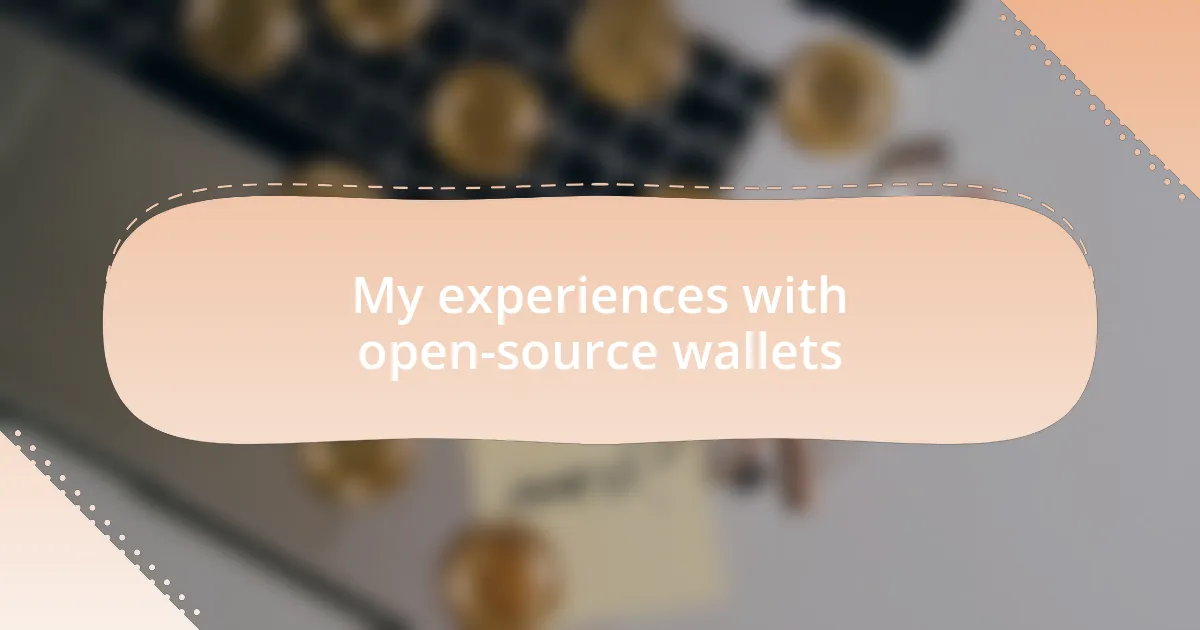
My experiences with open-source wallets
My journey with open-source wallets has been quite enlightening. I remember the first time I set up Electrum; it felt like unlocking a world where I was in control of my Bitcoin. The ease of customization and the confidence in using an open-source solution gave me a sense of ownership that I just hadn’t felt before with proprietary software. Isn’t it empowering when you know you can interact with something transparently?
Meanwhile, Mycelium has been my go-to for everyday transactions. I still recall the rush of sending my first few Bitcoin while standing in line for coffee—it was exhilarating! The mobile interface makes every transaction feel effortless, and I love how it allows me to quickly access my balance or make trades on the fly. Have you ever used an app that just clicks with your lifestyle? For me, Mycelium is that app, transforming complex processes into simple taps.
Then there’s Trust Wallet—a more recent addition to my digital toolkit. I was genuinely surprised by how quickly I adapted to its interface. The convenience of managing so many tokens in one place resonated with me, especially during the height of my crypto trading days. I often found myself reflecting on how crucial it is to feel at ease when handling assets, and Trust Wallet truly provided that comfort. Wouldn’t you agree that a well-designed wallet can make risks feel less daunting?
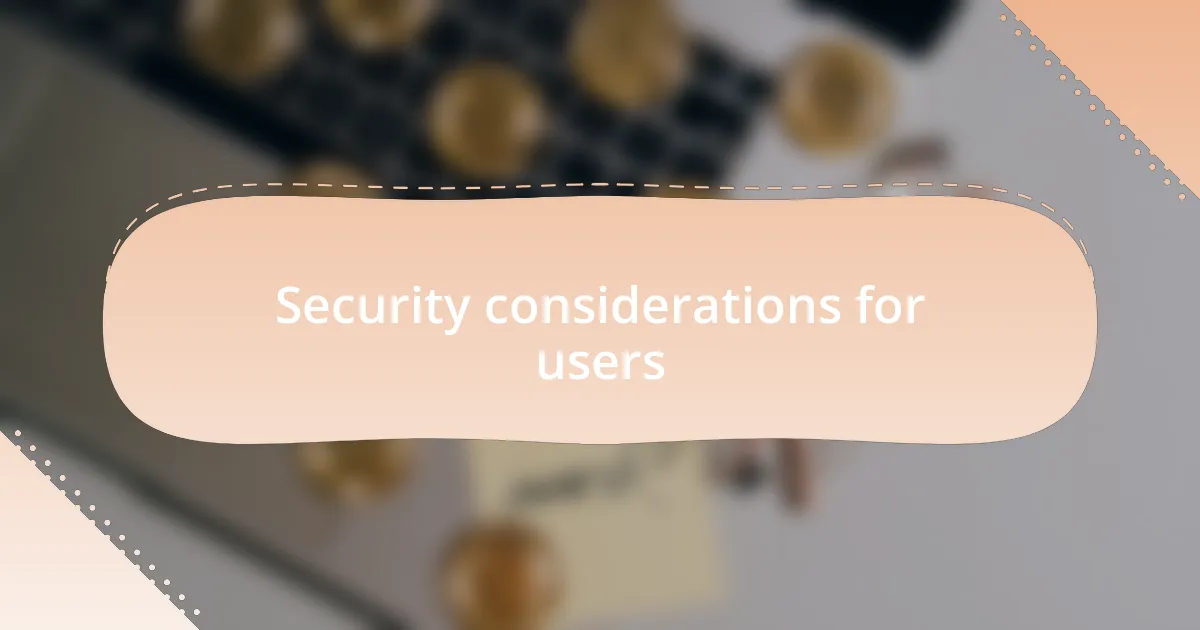
Security considerations for users
Security is paramount when it comes to using open-source wallets. I remember feeling anxious the first time I had to back up my wallet; the thought of losing my funds was terrifying. It’s essential to understand that while open-source software often allows for community-driven security improvements, users must still take proactive measures, such as securely storing recovery phrases and using strong passwords. How do you ensure your digital assets are safe?
When I first dived into the world of open-source wallets, I was struck by the importance of software updates. I learned the hard way that neglecting to update my wallet could leave it vulnerable. Regular updates not only patch security holes but also improve functionality. Have you ever experienced the relief that comes from knowing your software is up to date?
Additionally, I discovered that using two-factor authentication (2FA) can significantly bolster security. After setting it up, I felt a sense of reassurance when accessing my wallet. It’s like having an extra locked door to protect my valuables. Have you adopted any additional security measures to enhance your peace of mind?